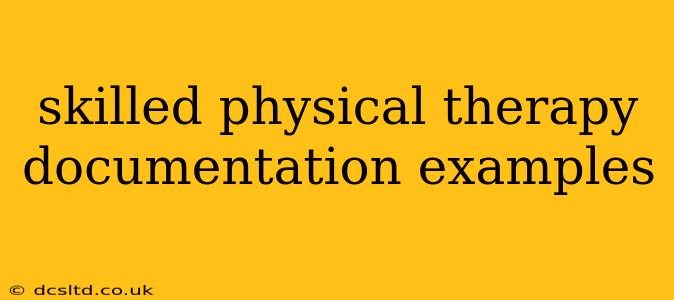Effective physical therapy documentation is crucial for patient care, insurance reimbursement, and legal protection. This guide provides examples of skilled physical therapy documentation, highlighting key elements and demonstrating how to showcase the complexities of your interventions. Remember, specific requirements vary based on your location and payer, so always refer to your local guidelines.
What Makes Physical Therapy Documentation "Skilled"?
Before diving into examples, let's define what constitutes "skilled" physical therapy. It's not simply performing exercises; it's the professional judgment and specialized knowledge a physical therapist applies to design and implement a treatment plan. This includes:
- Assessment of the patient's condition: Identifying impairments, functional limitations, and disabilities.
- Development of a plan of care: Setting measurable goals and choosing specific interventions to address the patient's needs.
- Implementation of skilled interventions: Performing manual therapy, therapeutic exercises, and patient education.
- Progress monitoring and reassessment: Tracking the patient's response to treatment and modifying the plan as needed.
- Documentation that justifies the need for skilled services: Clearly articulating the therapist's clinical reasoning and the rationale behind each intervention.
Skilled Physical Therapy Documentation Examples:
Here are examples focusing on different scenarios and showcasing how skilled interventions are documented:
Example 1: Post-Surgical Knee Replacement
Patient: 65-year-old female, post-total knee arthroplasty (TKA) 2 weeks post-op.
Assessment: Patient presents with significant pain (8/10) limiting weight-bearing, decreased ROM (0-90 degrees flexion), and quadriceps weakness. Edema present in the surgical knee. Patient reports difficulty with transfers and ambulation.
Plan of Care: Focus on pain management, improving ROM, strengthening quadriceps, and improving functional mobility. Interventions include:
- Manual therapy: Soft tissue mobilization to address edema and scar tissue restrictions.
- Therapeutic exercises: Range of motion exercises (active and passive), strengthening exercises (isometric and isokinetic), and functional exercises (e.g., sit-to-stand transfers).
- Modalities: Ice application to manage pain and edema.
- Patient education: Home exercise program, joint protection techniques, and safety precautions.
Progress Note (Week 1): Patient demonstrated improved ROM (0-100 degrees flexion) with manual therapy and active range of motion exercises. Pain reduced to 5/10 with ice and manual techniques. Initiated weight-bearing as tolerated with assistance. Patient is progressing well towards goals.
Progress Note (Week 2): Patient's ROM increased to 0-110 degrees flexion with continued active and passive ROM exercises and manual therapy. Quadriceps strength improved as evidenced by improved sit-to-stand transfers. Patient ambulates with a walker for 25 ft. Home exercise program was reinforced.
Example 2: Chronic Low Back Pain
Patient: 40-year-old male with chronic low back pain (6/10) for the past 6 months.
Assessment: Patient reports pain radiating to the right leg with associated numbness and tingling. Limited ROM in lumbar spine. Positive straight leg raise test on the right side. Muscle weakness noted in the right hip extensors and abdominals. Poor posture observed.
Plan of Care: Focus on pain management, improving ROM, strengthening core muscles, and improving posture. Interventions include:
- Manual therapy: Spinal manipulation, soft tissue mobilization, and joint mobilization techniques.
- Therapeutic exercises: Core strengthening exercises (planks, bridges), lumbar stabilization exercises, and flexibility exercises (stretching).
- Modalities: Heat therapy and electrical stimulation.
- Patient education: Ergonomic principles, body mechanics, and self-management techniques.
Progress Note (Week 1): Patient reported decreased pain (4/10) after manual therapy and heat application. ROM improved by 10 degrees. Patient initiated core strengthening exercises with good form. Educated patient on proper lifting techniques.
Example 3: Post-Stroke Rehabilitation
Patient: 72-year-old male with right-sided hemiparesis secondary to a stroke 3 months ago.
Assessment: Patient exhibits significant weakness in the right upper and lower extremities, decreased balance, and impaired coordination. Difficulty with functional mobility, including transfers and ambulation. Apraxia observed during functional tasks.
Plan of Care: Focus on improving strength, balance, coordination, and functional mobility. Interventions include:
- Neuromuscular re-education: Techniques to improve motor control, coordination, and strength in affected extremities.
- Therapeutic exercises: Strengthening exercises, balance exercises, and functional training (e.g., gait training, transfers).
- Assistive devices: Use of adaptive equipment to aid in functional mobility.
- Patient education: Strategies for improving safety and independence in daily activities.
Progress Note (Week 1): Patient demonstrated improved weight-bearing on the right leg, and initiated transfers with minimal assistance. Continued to work on range of motion exercises and strengthening exercises using progressive resistance training techniques. Gait training is scheduled for the next session.
Frequently Asked Questions (FAQs)
How often should I document?
Documentation frequency depends on the patient's condition and the complexity of the treatment. Generally, it is recommended to document each visit, including daily notes for inpatient settings.
What are the essential components of skilled physical therapy documentation?
The essential components include patient's history, assessment findings, goals, interventions, progress, and plan for future sessions. The documentation should be clear, concise, and support the need for skilled services.
How do I ensure my documentation demonstrates the complexity of my interventions?
Use specific, measurable terms to describe the patient's impairments and the interventions implemented. Explain the rationale behind your chosen interventions, and how they address the patient's specific needs. Clearly articulate the skilled judgment and expertise applied in your treatment.
By following these guidelines and examples, you can create skilled physical therapy documentation that accurately reflects your expertise, ensures appropriate reimbursement, and ultimately contributes to optimal patient outcomes. Remember to always consult with your organization's policies and procedures.
